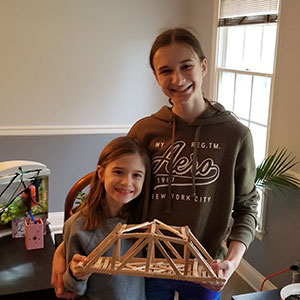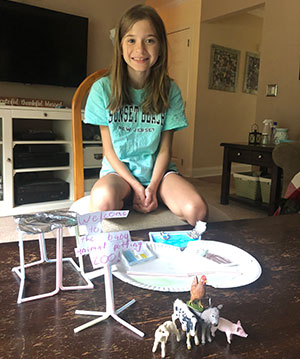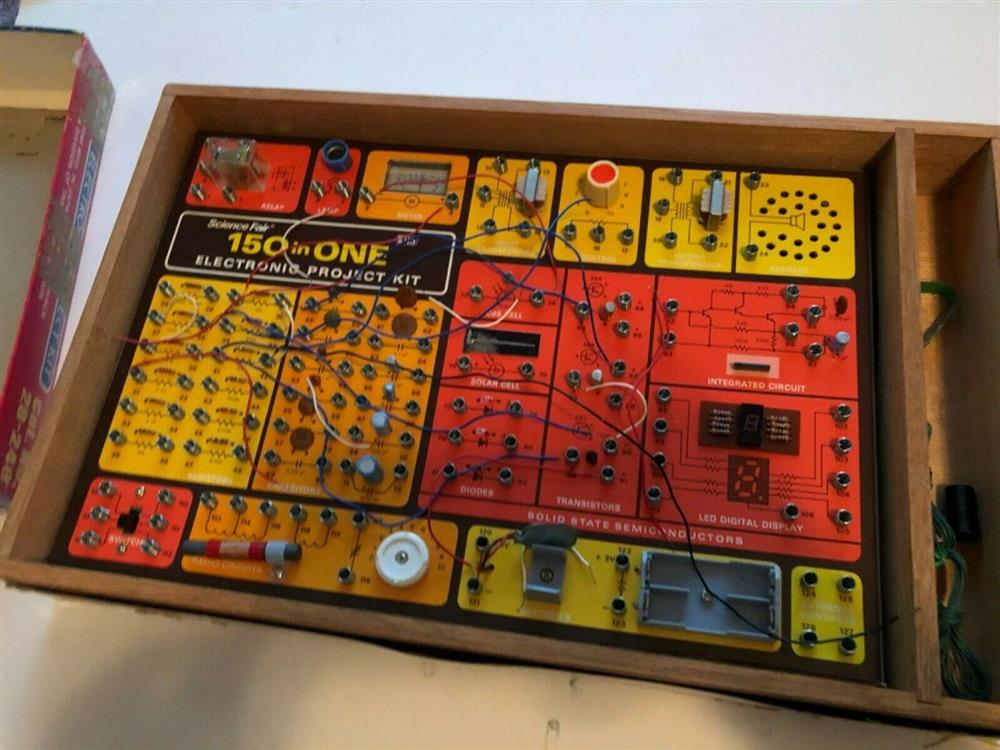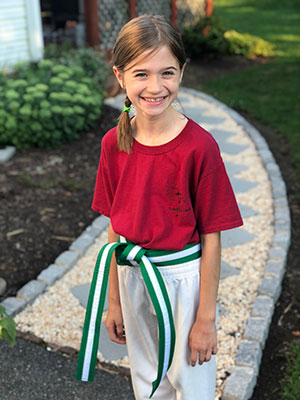So far, we are very happy with the progress of Leah's education. When Leah finished the initial batch of classes around the end of April, we decided to just keep up the momentum and moved her right into 4th grade classes. She finished her initial batch of classes at slightly different times, so as she finished a class, she devoted more time to the remaining subjects. In this way, we were able to finish all of the classes fairly close together. We intend to do the same with this batch.
Being it's summer, the daily goal will be lower. Her goal will be just one lesson per day per subject. Previously, she was doing two or three lessons per day. Even at this easy pace, my spreadsheet indicates she'll finish her fourth grade Powerhome School (PHS) classes around November. Math will run into the spring.
We are often asked how much time we spend on home education. Compared to the amount of time she would spend in institutional school, it's surprisingly little. We start every day with a morning meeting, including all of us. During that time, Leah and Samy both go over the main points of what they learned the previous day. I review their test results for the previous day (which takes me about 15 minutes for the two of them) and note any problems. It's not uncommon that Jana or I will ask questions about what they learned and they won't know the answer. We'll write those questions on the whiteboard for them to research during the course of the day and discuss the answer at the next day's morning meeting. They are also expected to bring "one extra fact" - something that relates to the topics they learned about, but which wasn't covered in the video lesson. The idea behind our questions and the one extra fact is to encourage them to dig deeper on their own. Morning meeting generally takes us all about 45 minutes.
Getting back to the time question, Leah can easily complete her PHS classes in about an hour. I spend about 15 minutes prepping for her math lesson, then we spend about a half hour going over the day's lesson. Leah also has a daily independent reading goal. So all together, Leah spends about three hours per day on formal education.
English
We used PHS's Grade 4 Language Arts/Reading. This course began at the end of April 2020 and we anticipate she will complete it by the end of October. It builds on what she learned last year and again covers what one would expect. These are the major components:
- Types of Texts
- Features of Nonfiction
- Narrative Writing
- Characterization
- Elements of Drama
- Informative Writing
- Organizing, Outlining
- Researching a Topic
- Compare/Contrast Informative Texts
- Speeches, Persuasive Writing
- Myths
- Comparing Point of View
- Poetry - Imagery
- Fact vs. Opinion; Fantasy vs. Reality
- Editing, Revising
Leah's goal is to complete only two lessons, but she almost always does more, because some of the lessons are brief. Almost daily there are spelling and vocabulary quizzes, so she is getting plenty of that. Overall, we were happy with the course, but there is again no writing component to the course. We are still trying to figure out how to include writing more fully into her studies.
Once Leah finishes this class, the plan it to allocate independent reading time into her day. She will be able to select from quality books, such as those on the Mensa for Kids reading list. We are also on the lookout for an appropriate writing class for her, probably through Outschool. Even though I can mostly scratch a sentence together, it really isn't my specialty and I would rather outsource that area.
Social Studies
We used PHS's Grade 4 Social Studies. Leah started this class at the end of April and we also anticipate it will be done around the end of October. This course covers these areas:
- The Regions of the United States
- American Diversity
- American Government
- Resources and Trade
- The Northeast Region
- People of the Northeast
- The Southeast Region
- People of the Southeast
- The Midwest Region
- People of the Midwest
- The Southwest Region
- People in the Southwest
- The Western Region
- People in the West
This looks to be a little more challenging than last year, but still a fairly easy class. Being it concentrates on the different areas of the country, it's a bit more interesting and diverse.
Science
We used PHS again for this - their Grade 4 Science class. Again, this is a survey class and it touches on many areas of science. Included is:
- Classifications of Plants and Animals
- Energy from Plants
- Ecosystems
- Changes in Ecosystems
- Human Body Systems
- Water Cycles and Weather
- Hurricanes and Tornadoes
- Minerals and Rocks
- Surface Changes on Earth
- Uses of Natural Resources
- Properties of Matter
- Heat
- Magnetism and Electricity
- Light and Sound
- Objects in Motion
- Inner and Outer Planets
- Technology's Effects
The instructor for this class is super-enthusiastic about teaching. Apparently she attended a NASA camp and frequently wears a blue NASA flight suit. She's a bit over the top, but definitely holds your attention. Leah began the class at the end of April and we anticipate she will complete it in early December.
We are still supplementing the PHS class with the book Building Foundations of Scientific Understanding. (More discussion about this here.) I still really like this book and the instruction it has to offer. It does require a significant amount of prep before each lesson, so I have to admit we are not progressing through the material as quickly as I would like. I am also seeing more overlap between what's in BFSU and what's in her PHS class.
Engineering

This year's elective is Elementary Engineering. Like ecology last year, Leah is enjoying this class a lot. There are some nice hands on projects that she is enjoying and the instructor is very good. The class consisted of these topics:
- Introduction to Engineering
- The Engineering Design Process
- Engineering project, building a zipline
- The design process of test, evaluate, and redesign
- Leonardo da Vinci and the benefits of sketching or drawing designs
- A new project is initiated targeting designing and making boats
- Alexander Graham Bell’s research, impact, and sharing solution are covered
- The work of the Wright Brothers and their impact, with a specific focus on their build of a prototype.
- Analyze the problem that led to the engineering of the Hoover Dam and the important step that the building of a prototype had in the design process.
- The Titanic and the failures in its design process are explored.
- Analyze the problem that led to the construction of the Golden Gate Bridge, followed by an analysis of the design process of the Golden Gate Bride.
- Learn about the invention of earmuffs and the story of the design process that brought this invention to reality.
- Analyze of The Eiffel Tower and its design process.
- Look at the work of kid inventor Abbey Fleck.
- Henry Ford and his important engineering accomplishments are analyzed.
- Analyze Benjamin Franklin and some of his important engineering work.

Each of the units includes a related hands-on project and a discussion of a related engineering field as a career. The instruction is very good and the topics are interesting. The only thing to be aware of is the quizzes are very, very easy. I think even a second or third grader would be able to do well on the quizzes.
Math
We still love Singapore Math! Leah has moved on to Dimensions Math 4A. This is not an online course - it's a physical book and I do the instruction one-on-one with her. I think she not only enjoys the interaction, but she learns faster because I can watch her and see the kinds of mistakes she makes and immediately correct them. This is a big winner and I intend to use this program through to the end at eighth grade. The topics covered include:
- Numbers to One Million
- Addition and Subtraction
- Multiples and Factors
- Multiplication
- Division
- Fractions
- Adding and Subtracting Fractions
- Multiplying a Fraction and a Whole Number
- Line Graphs and Line Plots
The general topics covered seem to repeat from course to course, but they are definitely covered with increasing levels of difficulty. Even so, Leah is finding the material in 4A fairly easy and is progressing through the books. There is a lot of material, though, and we anticipate she will be done in early October and will move on to the second half of the fourth grade at that point.
The set of books consists of a student textbook, an instructor manual (which explains the topic and goes over the examples in the textbook) and a workbook (answers are provided in the instructor manual). Throughout, there are tons of problems to work through in various formats. For example, there are challenging word problems, but also fun problems like solving codes or riddles by working through different problems. Overall, I'm very happy with the quality of this material. The 4A set of books cost about $50.
Electronics
This is something new. We signed up for a monthly subscription box through EEME.com (Electrical Engineering / Mechanical Engineering). We started this in May and have completed three of the projects so far. The projects use actual electronic components, not magnetic pieces. There is no soldering, because the components push into this thing called a breadboard, which is actually used for prototyping circuits. Each project comes with all of the components you need and a series of videos that walk you through the build process and explain how the circuit works. The subscription costs $20/month and I find it well worth it. I think being able to visualize how electricity flows through a circuit and how the different components change that flow is a very important skill. When I was a kid, I had this exact kit - and I got tons of use out of it!

The kit from my childhood had a lot of diversity, but I think Leah is learning more from going through a structured progression of projects. Note that many of the pieces are small and can be somewhat tightly positioned, so it does take a bit of dexterity to complete the project. I think Leah (9 years old) is at the younger end of being able to complete these kits.
History
We are going to try something a little different this year - we're planning to use Curiosity Chronicles. Even though it's a little below Leah's grade level, we are going to start at the beginning with ancient history. In the same way that we spice up Building Foundations for Scientific Understanding, we'll add material to this course to make it more full and challenging. The package consists of a student textbook, an instructor's guide, a student workbook, a timeline and an audio book version of the textbook. The workbook provides activities relating to the chapter at a range of age levels. In addition to providing more detail on the material covered in the lesson, the instructor's guide contains suggestions for supplementary material. The course consists of 36 chapters, so it's meant to be completed one chapter per week during the course of a traditional school year. Our plan is to go through this course co-op style. I would like to meet once a week to read through the chapter with a small group and discuss the previous week's homework and projects. In particular, there are suggestions for facets of the lesson that could be further researched. The text of the textbook is presented conversation style between two characters, so it lends itself to being read aloud.
Gardening
Interest in gardening has exploded in our family this year. We are working on a blog post specifically on this topic. We built two large raised beds, in addition to the four smaller ones we already had. At this point, the harvest is coming in and we are seeing an overwhelming number of cherry tomatoes, in addition to peppers, zucchinis and herbs. This was our trial year. Most of the effort was lead by Jana - she established how things could work and we learned some valuable lessons. Our plan is for the girls to be more involved in running this enterprise next season. The girls have really loved planting the seeds, watching them grow under the grow lights and then transplanting the seedlings. Watching things really take off in the garden and then harvesting has been such an amazing experience. Leah in particular has shown lots of interest in gardening. She is constantly picking things from the garden and counting the harvest. She is re-seeding things to watch the flowers grow again from the seeds she planted. At this point we have planted the Fall garden and are collecting seeds from everything we planted for next Spring. This has been such a valuable learning experience.
YouTube / Video Production
Leah is extremely verbal (i.e. never stops talking). Literally, from the second she wakes up until she falls asleep, she is talking. She is undeterred if there isn't anybody to listen to her. She'll talk to our pets, I've even seen her talking to a towel more than once. She's also had an interest in binge watching YouTube videos on subjects that interest her. Lately, she's watched dozens of videos on pet care. This all kind of started by watching videos on how to make slime. She's always liked the idea of having her own YouTube channel as a creative outlet. Well, recently Leah took a great class on Outschool, finally realize her dream of having her own YouTube channel (please help her out by visiting and subscribing to her channel). The specific class she took was "Start Your Own YouTube Channel!" This is a great experience for her, because it brings together so many worthwhile activities. She has to plan out her video, stick to a schedule, film it, narrate it, edit it (splicing clips, adding transitions and overlays, etc), then posting it on YouTube and promoting it to friends and family. I find it really incredible that she can take on the entire lifecycle of being a published journalist with very minimal involvement from Jana or myself.
Tuttle Twins
This is something else we are trying this year. The Tuttle Twins is a series of books aimed at children. The idea is to "introduce important ideas that schools no longer teach." Many of these ideas center around market economics, such as supply chains, free markets, supply and demand, entrepreurism, etc. They also delve into the role of government in our lives, which is especially relevant these days. The stories are based on classic works on the topic, but are told in the context of the lives of two siblings, so the ideas are very accessible to most any age. We also listen to their podcast. The podcasts are about 15 minutes long, so they are the perfect length for most short car rides. They deal with topics relating to the books and to current events.
Art History
This is a fun course we are taking as a family. It's offered through the University of California and costs only $29 for the semester. It's video based and on-demand, so you can go through the material for as long as you like. We find this course very easy to consume, interesting and informative. Unfortunately, we are having trouble finding the time to consistently watch the material, but we are in no hurry. The topics covered in this course include:
- Introduction to Art
- Elements of Design
- Principles of Design
- Art Making
- Art History Early Civilizations
- Early Christian to Gothic
- Renaissance to Rococo
- Early Modernism
- Modernism
- Exploring World Art
- Careers in Art
Girl Scouts
Leah has been a Girl Scout since kindergarten. Jana runs both Leah's Brownie troop and Samy's Cadette troop. Beginning in April, the troop was only able to meet by Zoom, which really takes a lot away from the experience. Hopefully we will be able to get back to normal quickly. Leah just bridged to become a Junior Girl Scout and Jana is busy planning a fun year with some in-person meetings and activities and some zoom meetings for when the weather gets cold. Let's hope they will be able and allowed to do in-person meetings sooner rather than later.
4H
This is Leah's other extracurricular activity, which we added in June 2019. Unfortunately, 4H prohibited in-person meetings during the quarantine and the club basically went into a holding pattern. The girls were able to do some activities offered through Rutgers (which sponsors 4H), but it's really not the same as being able to chase chickens like at our regular meetings.
Karate

This is Leah's sport. She's been taking karate at Golden Rule Karate and Fitness since 2017 and really enjoys it. It has done wonders for her self confidence. Leah has progressed to green belt, which means she is no longer a novice student and is now officially an intermediate student. This means she gets the opportunity to do things like lead the other students in drills and exercises. In August she was able to attend a week-long series of full day seminars (not a summer camp!), which she really enjoyed.
Conclusion
When we got a question about the amount of time a parent would have to spend on home educating their child, a Latin saying came to mind: Ex nihilo, nihil fit. From nothing comes nothing. You can plop your kid down in front of some videos and the outcome would most likely actually be better than nothing, but that's not what we are aiming for.
We are in a nice groove with the girls now where they work independently when we need to do work and where we spend so much time together as a family and exploring and learning together. Every day, I feel like we are given a new chance to instill the love of learning and give both girls the feeling of how important and special they are to us. We have enjoyed homeschooling and spending so much valuable time with them. We look forward to all the adventures still to come.
